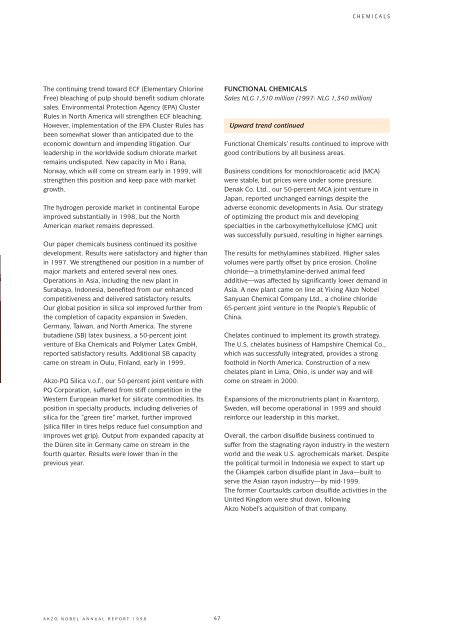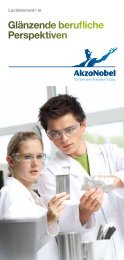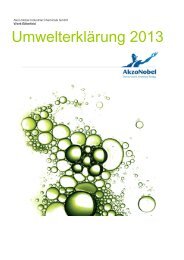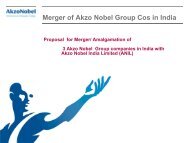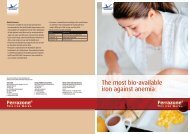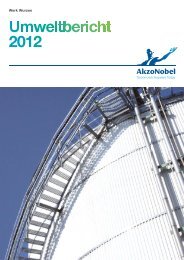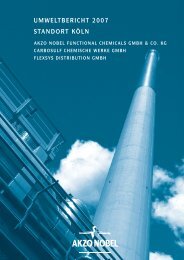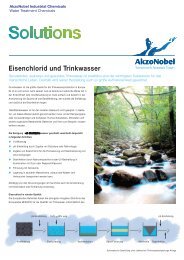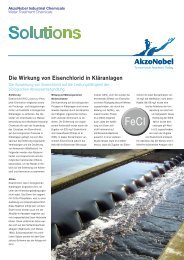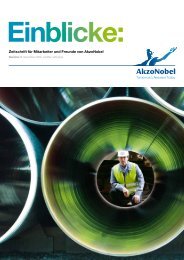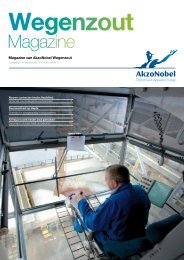You also want an ePaper? Increase the reach of your titles
YUMPU automatically turns print PDFs into web optimized ePapers that Google loves.
The continuing trend toward ECF (Elementary Chlorine<br />
Free) bleaching of pulp should benefit sodium chlorate<br />
sales. Environmental Protection Agency (EPA) Cluster<br />
Rules in North America will strengthen ECF bleaching.<br />
However, implementation of the EPA Cluster Rules has<br />
been somewhat slower than anticipated due to the<br />
economic downturn and impending litigation. Our<br />
leadership in the worldwide sodium chlorate market<br />
remains undisputed. New capacity in Mo i Rana,<br />
Norway, which will come on stream early in 1999, will<br />
strengthen this position and keep pace with market<br />
growth.<br />
The hydrogen peroxide market in continental Europe<br />
improved substantially in 1998, but the North<br />
American market remains depressed.<br />
Our paper chemicals business continued its positive<br />
development. Results were satisfactory and higher than<br />
in 1997. We strengthened our position in a number of<br />
major markets and entered several new ones.<br />
Operations in Asia, including the new plant in<br />
Surabaya, Indonesia, benefited from our enhanced<br />
competitiveness and delivered satisfactory results.<br />
Our global position in silica sol improved further from<br />
the completion of capacity expansion in Sweden,<br />
Germany, Taiwan, and North America. The styrene<br />
butadiene (SB) latex business, a 50-percent joint<br />
venture of Eka Chemicals and Polymer Latex GmbH,<br />
reported satisfactory results. Additional SB capacity<br />
came on stream in Oulu, Finland, early in 1999.<br />
Akzo-PQ Silica v.o.f., our 50-percent joint venture with<br />
PQ Corporation, suffered from stiff competition in the<br />
Western European market for silicate commodities. Its<br />
position in specialty products, including deliveries of<br />
silica for the ”green tire” market, further improved<br />
(silica filler in tires helps reduce fuel consumption and<br />
improves wet grip). Output from expanded capacity at<br />
the Düren site in Germany came on stream in the<br />
fourth quarter. Results were lower than in the<br />
previous year.<br />
AKZO NOBEL ANNUAL REPORT 1998<br />
47<br />
CHEMICALS<br />
FUNCTIONAL CHEMICALS<br />
Sales NLG 1,510 million (1997: NLG 1,340 million)<br />
Upward trend continued<br />
Functional Chemicals’ results continued to improve with<br />
good contributions by all business areas.<br />
Business conditions for monochloroacetic acid (MCA)<br />
were stable, but prices were under some pressure.<br />
Denak Co. Ltd., our 50-percent MCA joint venture in<br />
Japan, reported unchanged earnings despite the<br />
adverse economic developments in Asia. Our strategy<br />
of optimizing the product mix and developing<br />
specialties in the carboxymethylcellulose (CMC) unit<br />
was successfully pursued, resulting in higher earnings.<br />
The results for methylamines stabilized. Higher sales<br />
volumes were partly offset by price erosion. Choline<br />
chloride—a trimethylamine-derived animal feed<br />
additive—was affected by significantly lower demand in<br />
Asia. A new plant came on line at Yixing Akzo Nobel<br />
Sanyuan Chemical Company Ltd., a choline chloride<br />
65-percent joint venture in the People’s Republic of<br />
China.<br />
Chelates continued to implement its growth strategy.<br />
The U.S. chelates business of Hampshire Chemical Co.,<br />
which was successfully integrated, provides a strong<br />
foothold in North America. Construction of a new<br />
chelates plant in Lima, Ohio, is under way and will<br />
come on stream in 2000.<br />
Expansions of the micronutrients plant in Kvarntorp,<br />
Sweden, will become operational in 1999 and should<br />
reinforce our leadership in this market.<br />
Overall, the carbon disulfide business continued to<br />
suffer from the stagnating rayon industry in the western<br />
world and the weak U.S. agrochemicals market. Despite<br />
the political turmoil in Indonesia we expect to start up<br />
the Cikampek carbon disulfide plant in Java—built to<br />
serve the Asian rayon industry—by mid-1999.<br />
The former Courtaulds carbon disulfide activities in the<br />
United Kingdom were shut down, following<br />
Akzo Nobel’s acquisition of that company.


